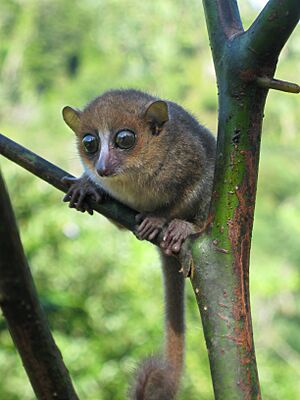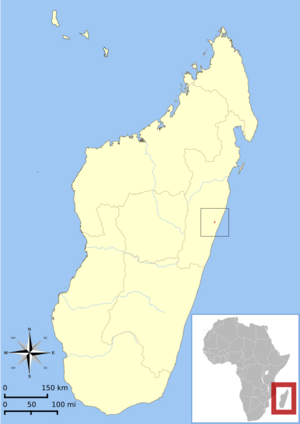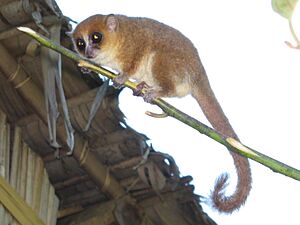Gerp's mouse lemur facts for kids
Quick facts for kids Gerp's mouse lemur |
|
|---|---|
 |
|
| Conservation status | |
| Scientific classification | |
 |
|
| Distribution of M. gerpi |
The Gerp's mouse lemur (Microcebus gerpi) is a tiny mouse lemur found only in the Sahafina Forest in eastern Madagascar. This special forest is close to Mantadia National Park. Scientists officially announced its discovery in 2012. A team of researchers from Germany and Madagascar found it.
Before 2008, the Sahafina Forest had not been explored much. Then, a group called GERP (Groupe d'Étude et de Recherche sur les Primates de Madagascar) started studying the lemurs there. This Malagasy group works to research and protect primates. The Gerp's mouse lemur is named after them!
Scientists used genetic tests, measurements, and photos to confirm this was a new species. It is different from Goodman's mouse lemur, which lives about 58 km (36 mi) away. Gerp's mouse lemur is much bigger. It weighs about 68 grams (2.4 oz) on average. Goodman's mouse lemur weighs only about 44 grams (1.6 oz). Jolly's mouse lemur is its closest relative and lives to the south. It is also large, but has a different tail length and different genes.
Since it was found recently, we don't know much about its daily life. We are still learning about how it behaves, communicates, and reproduces. This lemur seems to live only in a small area of lowland rainforest. It is seriously threatened because its forest home is being destroyed.
Contents
How Gerp's Mouse Lemur Was Discovered
The Gerp's mouse lemur was found by German and Malagasy scientists. They were part of the GERP organization. They discovered it in the Sahafina Forest, a lowland forest in eastern Madagascar. This forest had not been studied before. It is near Mantadia National Park.
The very first Gerp's mouse lemur specimen was caught on June 25, 2009. Scientists took genetic samples, measurements, and photos. Then, they released it back into the wild. At that time, they did not know it was a new species of mouse lemur. Two other lemurs were also measured and recorded.
The discovery was officially published in a science journal called Primates in 2012. The species was named after the GERP team that found it. Gerp's mouse lemur is different from its nearby mouse lemur relatives. It has different genes and looks different.
For example, its tail is longer than its closest relative, Jolly's mouse lemur (M. jollyae). Jolly's mouse lemur lives further south and has a tail that is 18% shorter. Gerp's mouse lemur also weighs more (68 grams or 2.4 oz). It is generally larger than Goodman's mouse lemur (M. lehilahytsara), which weighs about 44 grams (1.6 oz). Gerp's mouse lemur also has big genetic differences from its northern neighbor, Simmons' mouse lemur (M. simmonsi).
Scientists did genetic tests on the lemurs. These tests showed that the mouse lemurs from Sahafina Forest were a unique group. They were different enough from other mouse lemurs to be called a new species.
What Gerp's Mouse Lemur Looks Like
Gerp's mouse lemur is one of the larger mouse lemurs. It has a long tail, which can store fat. Its fur is darker on its back. It is brownish-gray with a reddish line down the middle. The fur on its front is lighter, from light gray to creamy white.
Its outer arms and legs are darker than the rest of its body. Its fingers have thin, whitish-gray fur. The lemur's head is reddish. Darker brown fur surrounds its eyes. It has a clear white stripe across its nose and between its eyes. Its ears are small but easy to see, with dark brown edges. The tail has thick, long, brownish-gray fur.
The skin on its hands and feet is pinkish-brown. Gerp's mouse lemur weighs about 68 grams (2.4 oz). Its tail is about 146.5 mm (5.77 in) long. It is considered a large mouse lemur. Many other large mouse lemurs also have long tails.
Its ears are small, measuring 19 to 20 mm (0.75 to 0.79 in). This is common for mouse lemurs that live in rainforests. Mouse lemurs from dry, western forests usually have larger ears. Scientists have not found any weight differences between male and female Gerp's mouse lemurs yet. More studies are needed to be sure.
Behavior and Life Cycle
Right now, scientists do not have much information about the behavior of Gerp's mouse lemur. We don't know how they communicate with each other. We also don't know much about their daily life, what they eat, or how they reproduce. Learning more about these things could help confirm its status as a unique species.
Where Gerp's Mouse Lemur Lives
Gerp's mouse lemur has only been found in the Sahafina Forest. This forest is in eastern Madagascar. It is about 58 km (36 mi) east of Mantadia National Park. It is also about 87 km (54 mi) south of the city of Toamasina. The forest is only about 18 km (11 mi) from the Indian Ocean.
The Sahafina Forest is a small piece of forest. It is about 15.6 square kilometers (6.0 sq mi) in size. It is surrounded by new forests growing in areas that were once cut down for rice farms. These areas are called savoka by local people.
The Sahafina Forest is low, from 29 to 230 meters (95 to 755 ft) above sea level. In contrast, Mantadia National Park, where Goodman's mouse lemur lives, is much higher. It ranges from 900 to 1,200 meters (3,000 to 3,900 ft) above sea level. There are no big rivers separating these high and low forests.
The area where Gerp's mouse lemur lives is likely no bigger than 7,600 square kilometers (2,900 sq mi). This is smaller than the island of Puerto Rico. More studies are needed to fully understand how far its home range extends.
Protecting Gerp's Mouse Lemur
There are no special protected areas within the known home range of Gerp's mouse lemur. It lives in lowland forests. These forests are more likely to be cleared for farming than highland rainforests. This means the Gerp's mouse lemur faces a very high risk of losing its home.
Out of its possible 7,600 square kilometer (2,900 sq mi) home range, only very small parts are still covered by forest. This makes protecting this species very important.



